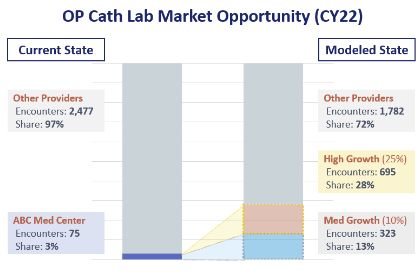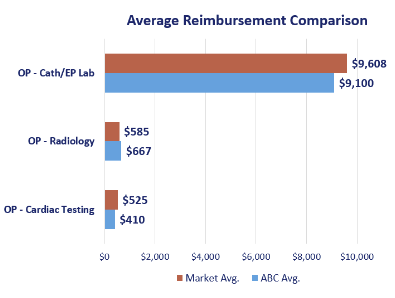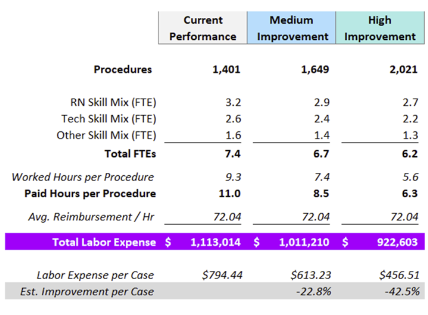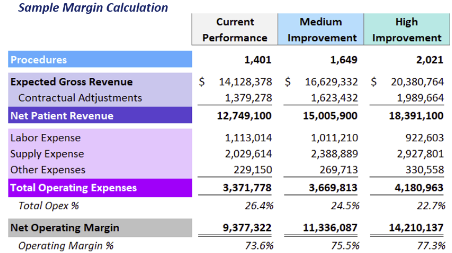Data has immense potential to help healthcare leaders make informed decisions in a turbulent healthcare environment. For data to be actionable, however, leaders need the ability to pull the right data together and present it in a way that tells a clear and compelling story.
To demonstrate how healthcare data analytics can help inform vital organizational decisions, consider the following case study of a fictional health system in Omaha, Neb., looking to grow its cardiology practice and associated cardiac catheterization (Cath) lab services. Some questions the health system’s leaders need to answer include:
- In what geographic market areas should we look to expand?
- What are other organizations doing in these areas and how do we compare?
- What patient volumes could we expect?
- What will the revenue implications be?
- How will it affect our costs and labor needs?
Service line planning is a complex process that involves many layers of analyses. Through the case example, this blog reviews how to use data analytics in healthcare, including samples of data visualizations that can help health system leaders develop an optimal growth strategy.
Step 1: Use spatial analysis (maps) to pinpoint market opportunities
To understand what’s happening in the market, the first step is to analyze cardiology patient volumes across the service area. A spatial analysis such as the one shown here allows healthcare leaders to visualize market data in a familiar format. The map overlays where the health system’s current cardiology patients live, as drawn from two years of electronic medical record (EMR) data, compared to reimbursement data on all cardiology patients living in the area.
The health system’s primary hospital, ABC Medical Center, is designated by the blue “H” in the center of the map, while the other “Hs” indicate competing hospitals. The dark blue dots are current ABC Medical Center patients, and the shaded areas reveal concentrations of all individuals who received a cardiology diagnosis within the same two-year period, drawn from All-Payer Claims data.
By overlaying the EMR and claims data, leaders can easily see where they are missing out on potential cardiology patients. The analysis reveals the health system has a lot of cardiology volume in and around ABC Medical Center, but it also reveals some gaps. The yellow circles indicate three zones that offer opportunities due to high volumes of cardiology patients receiving care from other providers.
These are areas where the health system can target its growth efforts. For example, ABC’s leaders may look to build additional cardiology services across the state line east of the city to draw more patients from Iowa (zone C). They may also consider opening more services in the northwest part of the city in zone B.
Step 2: Project growth potential with stacked bar charts
By analyzing claims data, health system leaders can more precisely pinpoint growth opportunities in these specific geographic areas. The first stacked bar chart compares ABC Medical Center’s current cardiac Cath lab patients versus patients going to other health systems for those services in zones B and C. According to the analysis, ABC Medical Center has significant untapped potential to expand these services, with just 3% of the market share or about 75 of nearly 2,500 total Cath lab encounters coming from the target zip codes.
Healthcare leaders can then project different levels of growth opportunities. This example calculates a medium-growth scenario where ABC Medical Center grows Cath lab services 10% versus a high-growth 25% growth scenario (see second bar chart). Under the medium-growth scenario, the health system would have 13% of the market or about 323 Cath lab encounters per year. Under the high-growth scenario, they would have 28% of the market or about 695 Cath lab encounters per year.
This type of bar chart clearly contrasts the current state versus growth projections, helping health system boards and other stakeholders better understand the opportunities.
Step 3: Compare reimbursement rates with clustered bar charts
A next step in assessing the potential expansion of Cath lab services involves diving into reimbursement rates. An analysis of 835 All-Payer Claims Remit data compares average reimbursement rates at ABC Medical Center versus the market average reimbursements for selected procedures. The clustered bar charts compare reimbursements for Cath lab, radiology lab, and cardiac testing procedures in proposed growth zones B and C.
The analysis of outpatient Cath Lab procedures shows that ABC Medical Center is getting more than $500 less per encounter compared to the market average — at $9,100 versus $9,608 — for patients in those zip codes. The health system’s leaders can use this information to negotiate better rates with healthcare payers and improve the overall revenue potential for expanded Cath lab services.
Step 4: Use cost modeling to illustrate economies of scale
Another step in evaluating growth opportunities is to assess projected costs. This cost model looks specifically at externally benchmarked labor costs, broken down by registered nurse (RN), technologist, and “other” clinical staff skills mix to determine total full-time equivalents (FTEs) needed under medium- and high-growth scenarios. Under the high-growth scenario, for example, the health system would improve efficiencies and reduce FTEs from 7.4 to 6.2.
The analysis then calculates how those FTEs would translate in terms of Worked and Paid Hours per Procedure. Paid Hours per Procedure would decrease from 11 to 6.3 under the high-improvement scenario, which would drive down labor expenses more than 42%, from $794.44 to $456.51 per case.
With these calculations, healthcare leaders can demonstrate labor cost savings that would result from expanded Cath lab services. By reducing FTE load, being more selective of the cases coming in, and getting more efficient in turning those cases around, the healthcare system can dramatically improve labor costs.
Step 5: Assess overall opportunity with a financial model
To look at the overall picture, healthcare leaders can combine what they have learned through previous healthcare data analytics. This financial model compares data for the current state versus the medium- and high-improvement scenarios across revenues and expenses to determine Net Operating Margin projections for each.
Under the high-improvement scenario, ABC Medical Center would grow Net Patient Revenue approximately $5.7 million, from $12.7 million currently to $18.4 million. At the same time, Labor Expenses would decrease from $1.1 million to $922,603. Net Operating Margin would grow $4.8 million, from $9.4 million to $14.2 million under the high-improvement plan.
Armed with these data and visualizations, healthcare leaders can provide the board and other stakeholders a compelling business case for ABC Medical Center to expand cardiology and Cath lab services into the B and C target zip codes.
To build these capabilities at your organization, tools such as Syntellis’ Axiom™ Market Opportunity Analysis and Axiom™ Market Opportunity Visualization enable healthcare leaders to draw from large, complex datasets, conduct robust healthcare data analytics, and clearly communicate your findings in easy-to-understand reports, charts, or other visualizations.
Watch the webinar to learn more.

Create a Compelling Narrative with Data Analytics
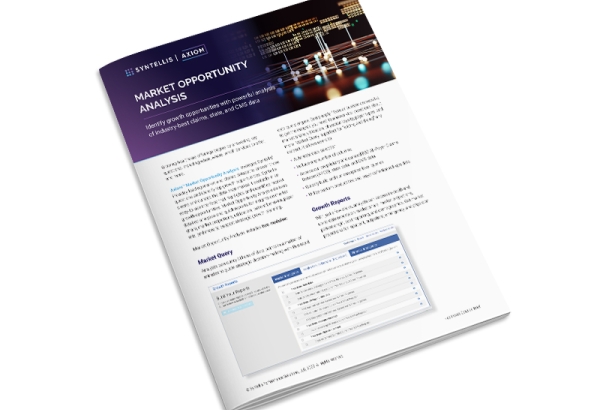
Axiom Market Opportunity Analysis




